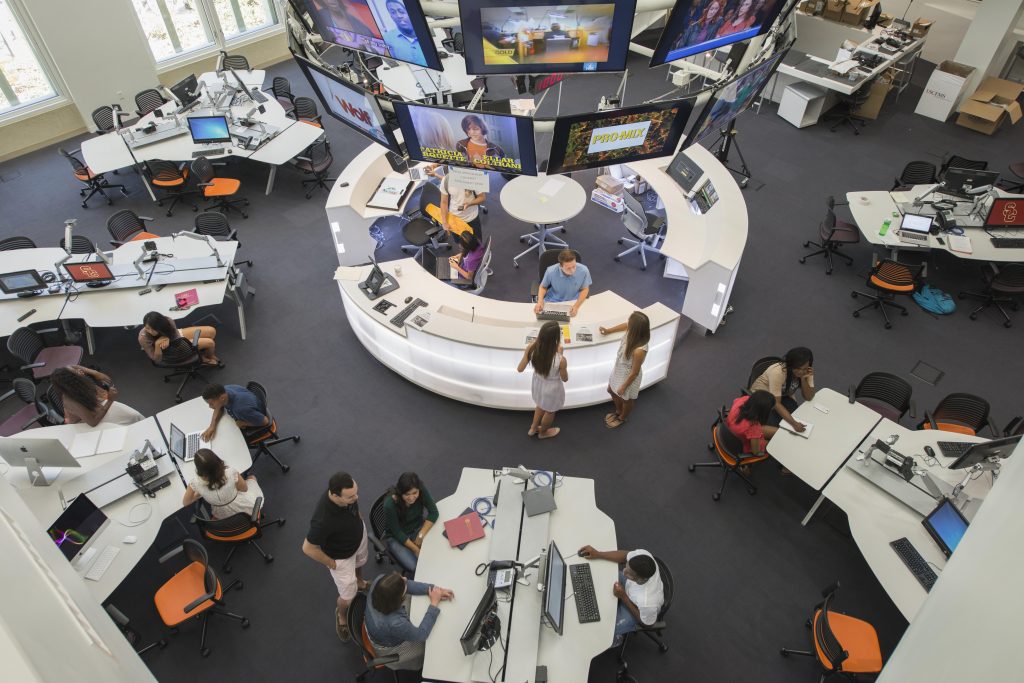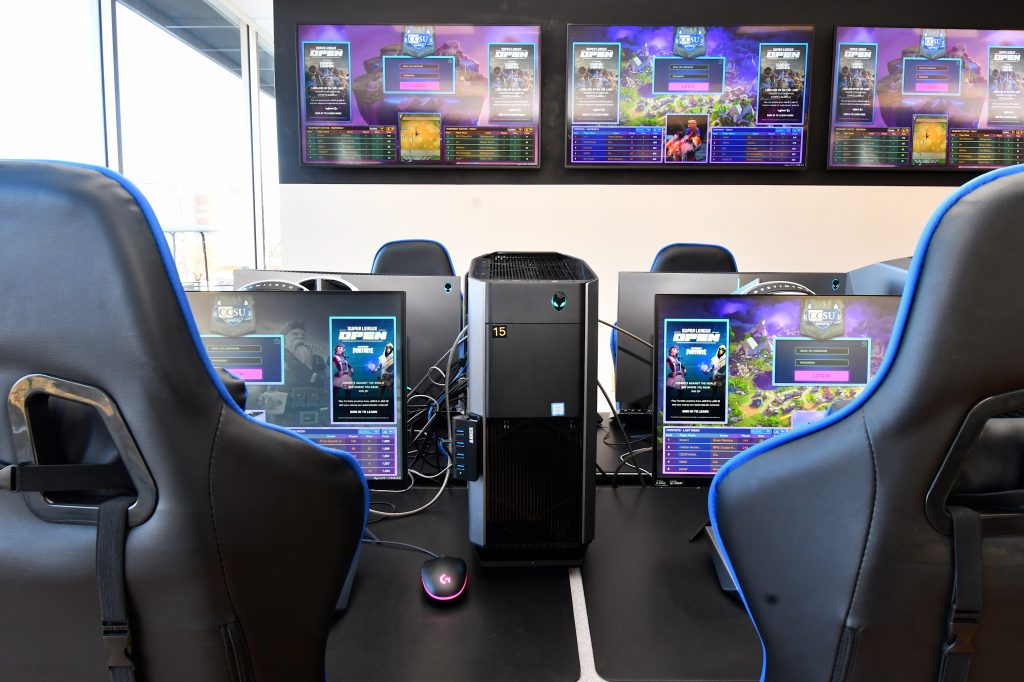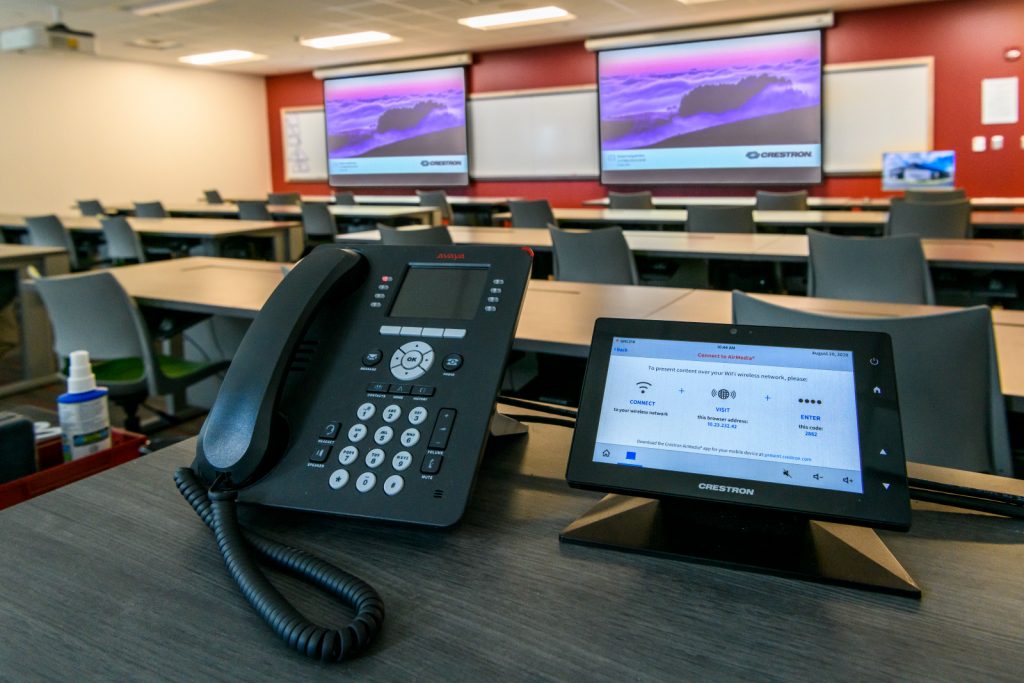The Future of Higher Education Must Avoid Returning to the Past

Colleges and universities can make higher education safer, smarter, and more accessible through automation and collaboration technologies – if they commit to it.
Author: John Hulen, Director of Channel Marketing, Education, at Crestron Electronics
Intro
With a year of hybrid or fully remote learning in the books, colleges and universities may be seeing the writing on the wall – or rather, the screen – about the future of higher education. A digitally-enriched, future-proofed, and layered education experience is simply what students, faculty, and other stakeholders expect moving forward.
It is important to understand that the pandemic did not initiate the transition to this next phase of education. That means even when the pandemic recedes, there is no going back to the way things were. Nor, frankly, should there be any desire to. The way my middle-school-aged kids learn is so much more sophisticated than the way I learned, and if that gap exists over our 25-year age difference, it should be obvious that a gap exists over the past two years as well, especially as advancements in education technology have only accelerated. And just as I would not go back to the way education worked a quarter-century ago, we should not want to return to the way it worked two years ago either.
We have turned a corner in terms of technology’s ability to facilitate education, so pandemic or no pandemic, the schools that commit to digitally transforming their learning environments will attract, retain, and produce graduates that transition most successfully into the working world, while schools slow on the uptake may struggle to recruit and develop equivalent talent. This is not to say that technology can or should be used to create cookie cutter “one size fits none” experiences, but rather that technology can help facilitate a more personalized and productive experience for all involved.
Let’s explore the efforts of a few colleges and universities (diverse in size, scale, and endowments) to illuminate what the present and future of higher education looks like through the lens of deploying campus-wide automation and technology solutions. Interestingly, as we explore these schools, you’ll see many of these projects initiated ahead of the pandemic but gained additional administrative support during the same period, and continue to reevaluate their on-campus technology systems as they prepare for the 2021-2022 schoolyear.
Creating a Safer Campus by Creating a Smarter Campus

Any return to campus push must begin with the recognition that it need not require a return to 100% of in-person events. Snow days, common illnesses, and any number of other interruptions will still happen once COVID-19 is gone, so schools will need to remain flexible. This can be hard to accept as everyone so desperately wants to “go back to normal,” but that is why a school like the University of Southern California (USC) presents such a sterling example. Because USC began their project in 2019, their ultimate goal was not a return to some lost sense of normalcy, but rather a more absolute pursuit of an improved experience.
“Back in 2018 and 2019 we couldn’t have predicted a pandemic would so soon shatter our vision of education, but we were able to perceive that a shift was happening in the way students, faculty, and staff learned, taught, and engaged with the campus and each other,” said Joe Way, Director, Learning Environments for USC. “With over 800 Crestron DM-NVX AV-over-IP endpoints installed throughout lecture halls, conference rooms, and over 250 classrooms, our campus can deliver a learning experience for students and faculty that fosters collaboration, creativity, and forward thinking – skills that will serve them well as they graduate and embark on their careers.”
When considered holistically, the connected campus deployed by Way and his team deliver greater functionality with less equipment, incorporating accessibility features like room automation and touchless voice control, natively integrated collaboration platforms and wireless presentation tools, along with sensors that monitor capacity and send automated alerts about the status of campus spaces.
The improved usability of the digitally transformed campus is already paying dividends for students, faculty, and administrative staff, beyond the expected flexibility of remote learning. No longer do students need to hunt across campus for an open study room, as room scheduling software lets them do that digitally. No longer will professors compromise their credibility by struggling with wires before presenting, as intuitive UC tools create a standardized platform, compatible with a BYOD approach, from which users can toggle between preferred collaboration applications. The result of these new technologies is a simpler, more sustainable, and more scalable system that will serve the university’s needs going forward.
“We knew education was heading in this direction, but we didn’t realize our timing would be so perfect,” said Way. “My advice to other schools thinking about standardizing their campus across a single technology platform like Crestron’s would be that you cannot act soon enough because even though technology will continue to evolve, waiting only puts you further behind.”
But while USC has done an excellent job integrating smarter technology that streamlines learning on campus and off, other schools have pursued technology projects that prioritize recruitment and retention, along with return.
Future-proofing Student Success

While a smart and safe return to campus is obviously a priority for nearly every university right now, some schools are equally focused on using technology changes to attract and produce graduates who are prepared for the working world. Nurturing technology fluency will position students to enter the next phase of their lives seamlessly. At Central Connecticut State University, this approach appears both in and outside the classroom.
“CCSU is completing construction of both an Education and Engineering building this semester. These buildings are designed to be next-generation learning environments so CCSU needed to find a way to incorporate cutting edge technology in classrooms and labs while making it easy to access by students and teachers.” said Dr. George Claffey, CIO of CCSU. “We took lessons from last year’s eSports Center, which similarly unified disparate technologies ranging from consoles to gaming computers to teaching stations.”
This eSports Center has proven a remarkable success so far. As the current and future site of Connecticut’s high school eSports championships, the space is clearly impacting prospective students and future graduates as designed. With the addition of eSports-related academic courses inside the space, “CCSU students will be among the most employable in the state, and beyond,” according to school president Dr. Zulma R. Toro. “The CCSU eSports Center is not just a video game lounge,” she continued, “it is a place where academics, research, and gaming meet and will soon expand CCSU’s mission to be a driving force of the economic, cultural, and intellectual development in Connecticut.”
While the technology in the eSports Lab attracts and nurtures interest in STEM careers, a point of focus for CCSU within Connecticut’s state university system, similar technology can be found in CCSU’s classrooms helping prepare students for other post-college careers by providing them the skills they need to excel in the 21st century economy.
“When CCSU needed to create HyFlex learning environments, we needed to drop PTZ cameras, microphones, and demonstration tables into classrooms across campus to support that,” continued Claffey. “We turned to Crestron to be the hub or brain of a new, advanced, set of interconnected technologies. Leveraging an intuitive interface and pre-programed code, we were able to provide professors a familiar way to use tools such as projectors, document cameras, and connected HDMI devices while also allowing them to turn on HyFlex cameras, microphones, and setup “scenes” for teaching or demonstrating to students at home. Many of our classes included student presentations so the students similarly began using these technologies in classrooms and specialized groups spaces across campus, as well.”
Though the pandemic certainly shattered the status quo for supply and demand of skilled labor, the U.S. Chamber of Commerce actually published a report one month prior to the pandemic indicating that 74% of hiring managers said there was a lack of skilled talent in recent years. What this means for colleges and universities is that they need to do a better job getting their graduates ready, and with the working world now turned hybrid, the skills graduates will need are those that are most important within newly hybridized environments: technology fluency, remote collaboration, an understanding of automation tools, and a familiarity with a digitalized learning and working experience.
This is exactly the experience CCSU has created for their students, who are placed into a campus that communicates constantly across its digital infrastructure. With these tools in place, as well as new teaching and collaboration spaces, students will develop comfort with the technology. The experiences and processes of a hybrid learning environment prepare them perfectly for the hybrid working world that awaits. The digitally transformed campus also allows students a deeper look into potential careers by allowing access to remote resources in the form of guest speakers, distant researchers at far-flung sites, and virtual “hands-on” experiences that would otherwise be unrealistic.
“The COVID19 pandemic brought with it consistently changing rules, regulations, and plans. We were happy to partner with a technology platform such as Crestron which could change as our plans evolved. As we look to the future, we’re looking at how to leverage these technology investments to help students connect with next generation technology and virtually collaborate with peers and the business world in real-time. When we talk to our industry partners, they tell us ‘CCSU graduates are ready to start working on day one.’ That’s a differentiator for our students and our institution that we take pride in.”
Accessibility for All

In a conference session from CES 2021, John Katzman, the CEO of Noodle, argued that perhaps the most impactful usage of technology for the future of education was not its ability to make learning more accessible from a physical standpoint, but how it will make learning more accessible from a financial standpoint. While tuitions are unlikely to decrease as a result of a campus technology overhaul, there are countless other areas where a new technology infrastructure can help hem in costs, improve access to resources, and allow students, faculty, and staff to extract more value from their campus experience.
Hudson Valley Community College (HVCC) sets an inspiring example for other small colleges in each of these areas. A low-tuition school that prioritizes graduating students with opportunity rather than debt, HVCC sought to improve their technology infrastructure in pursuit of creating a world class education experience that was truly open to the world, in every sense of the word. Standardizing all 260 academic spaces across their campus with Crestron automation and collaboration technology has helped them create a more effective, equitable, and educational experience for all stakeholders.
“Prior to the school standardizing the campus on Crestron platforms, HVCC IT managers wasted hours and hours shuttling across campus playing whack-a-mole with technology issues that now can serviced remotely,” said Jon Brennan, CIO of HVCC. “Using Crestron cuts downtime dramatically and with technology issues now addressable both remotely and in real-time, our IT team is able to focus on the future. This has made us a much more efficient campus because every dollar we used to lose to IT support inefficiencies can now be dedicated somewhere else, thereby giving students a better experience for their money. This is exceptionally important for us as a commuter school where students expect a world-class education without the world-class price tag.”
Taking care of their commuter students is a major priority for HVCC, given they account for 100% of their enrollment. The Crestron technology integrated into every academic space on campus means these students have alternatives in the event they are unable to make it to campus – never an unrealistic proposition considering under 50% of college students bring a car to campus, according to the most recent data available from U.S. News and World Report.
For HVCC, car travel pervades their entire existence, so creating an educational infrastructure that eliminates the requirement for a car – and thus the immense financial burden of its purchase and maintenance – renders HVCC a viable academic option for a much broader swath of students across a wider range of socioeconomic backgrounds. Similarly, automation and collaboration technology will also allow for larger class sizes and larger enrollments at HVCC, without reducing education quality, as educators will be able to broadcast their lectures online to students anywhere and everywhere. This is a major benefit for the many HVCC professors who also teach elsewhere.
The downstream impact of these connected classrooms has shown up in a variety of areas that will help position the school to be flexible to individual’s needs in the moment and the school’s needs in the future, whatever they may be. This rings truest for students who can leverage classroom collaboration technology for virtual yoga classes, cooking courses, book clubs, and even online fashion shows. These digitized social interactions allow for greater participation by students who are more comfortable in the digital realm. Further, they reflect the goal of cultivating a learning environment which broadens and expands student engagement using modern tools.
Conclusion
As each of these schools have shown in their own way, education is not about packed classrooms, rigidly defined rules and traditions, or exclusively-priced fluff for young adults. It is about meeting students where they are and empowering them to reach to their desired life goals. Automation and collaboration technologies are the most effective and efficient way of facilitating this development. As schools attempt to re-open to full capacity, they should consider how technology can enable them to bring everyone back to a better, brighter and more engaging experience that readies them for whatever comes next.”
John Hulen is the Director of Channel Marketing, Education for Crestron Electronics. He has been in the AV industry for 22 years and has worked for Crestron for 9 years focusing on the Education vertical market. He has a team of 15 A+ Partner Managers across the US & Canada who work with colleges, universities, all types of higher-ed institutions, as well as some K-12 school districts. John is passionate about how technology helps us learn now and how the decisions made today about technology will influence the next generation of students.






